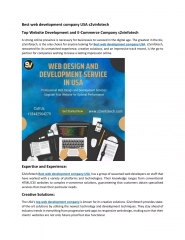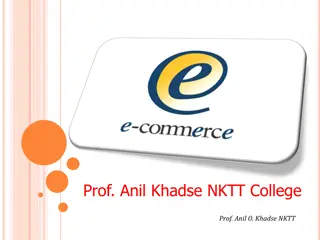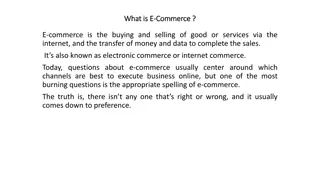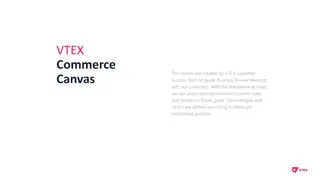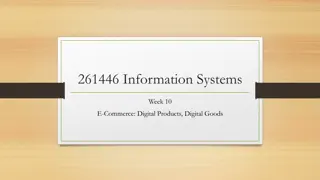E-Commerce Application Development Basics
In this content, you will explore the fundamentals of e-commerce application development, including web server basics, dynamic content generation, platform neutrality, and server architectures. Discover the multiple meanings of servers and the tools used to create dynamic web pages with various software frameworks and languages.
Uploaded on Apr 12, 2025 | 1 Views
Download Presentation

Please find below an Image/Link to download the presentation.
The content on the website is provided AS IS for your information and personal use only. It may not be sold, licensed, or shared on other websites without obtaining consent from the author.If you encounter any issues during the download, it is possible that the publisher has removed the file from their server.
You are allowed to download the files provided on this website for personal or commercial use, subject to the condition that they are used lawfully. All files are the property of their respective owners.
The content on the website is provided AS IS for your information and personal use only. It may not be sold, licensed, or shared on other websites without obtaining consent from the author.
E N D
Presentation Transcript
COM 3105 E-COMMERCE APPLICATION DEVELOPMENT Hans Yip
Learning Objectives Web Server Basics Dynamic Content Generation Multiple meanings of Web Server Cloud Computing
Web Server Basics Client/server architectures used in LANs, WANs, Web Server computers have more memory and larger, faster disk drives than the client computers they serve Web browser: a type of Web client software Platform neutrality is the ability of a network to connect devices using different operating systems Critical in rapid spread, widespread Web acceptance Web server s main job to respond to Web client requests Main elements: Hardware, operating system software, and Web server software
Platform Neutrality of the Web
Dynamic Content Generation Static page is an unchanging page retrieved from stored Web server file(s) Dynamic page created in response to user request Customized pages give user an interactive experience Client-side scripting software operates on the Web client (browser) and changes Web page display in response to a user s actions (JavaScript or Adobe Flash) Server-side scripting program runs on a Web server and creates Web page in response to request for specific information from a Web client
Dynamic Content Generation Software tools to create dynamic Web pages Microsoft ASP.NET, Apache Software Foundation Hypertext Preprocessor (PHP) and Adobe ColdFusion AJAX (asynchronous JavaScript and XML) creates interactive Web sites that look like applications Ruby on Rails, Scala and Python (scripting language) are used to accomplish the same objectives Many Web sites use more than one language and/or development framework to accomplish specific objectives
Multiple Meanings of Server Server is any computer providing files or making programs available to other computers connected to it through a network Server software makes files and programs available May be part of the operating system (OS) and be referred to as server software (confusing) Some servers connected to Internet via a router Runs Web server software that makes server s files available to other computers and called a Web server E-mail server: handles incoming and outgoing e-mail Database server runs database management software Transaction server runs accounting and inventory management software
Web Client/Server Architectures Basic model is two-tier client/server architecture One client and one server computer
Web Client/Server Architectures Three-tier architecture allows additional processing before server responds to client s request Often includes databases and related software applications that supply information to the Web server Web server uses software applications output when responding to client requests N-tier architectures have more than three tiers Track customer purchases stored in shopping carts Look up sales tax rates keep track of customer preferences, update in-stock inventory databases Keep product catalog current
Web Server Software Commonly used programs are Apache HTTP Server and Microsoft Internet Information Server (IIS) Some businesses, such as Google, wrote their own Apache dominant Web server software since 1996 Free and user-supported with other services available Microsoft IIS bundled with Microsoft Windows Server OS and runs only on Windows systems Used on many intranets, and small and large sites that have adopted Microsoft products as standard ISS is free but OS it comes with can be expensive
Web Server Hardware Wide variety of computer brands, types, sizes used by organizations to host online operations Small companies run Web sites on desktop PCs Most online business operations are operated on computers designed for site hosting Businesses select specific hardware and software elements based on site s functionality, expected visitors, number and size of pages and graphics
Server Computers Generally have more memory, larger (faster) hard disk drives and faster processors than typical desktop computers Many Web server computers use multiple processors Most companies spend $2,000-$50,000 on an individual Web server with large organizations spending millions on server hardware May be housed in freestanding cases but most are installed in equipment racks Blade servers are servers-on-a-card Small in size: 300 installed in single 6-foot rack
Web Servers and Green Computing Significant electrical power needs for operating servers and cooling the room where servers housed Green computing is efforts to reduce environmental impact of large computing installations Novel approaches using natural cooling Google server facility in Finland Facebook server in Lulea, Sweden Other companies: Hewlett-Packard, FedEx, Harris Corporation
Web Server Hardware Architectures Electronic commerce Web sites use tiered architecture to divide work of serving Web pages May use more than one computer within each tier Server farms are large collections of servers lined up row after row Centralized architecture uses a few expensive, fast computers and more sensitive to technical problems Requires adequate backup plans
Web Server Hardware Architectures Distributed architecture (decentralized architecture) uses many less-powerful, less-expensive computers Spreads risk over large number of servers Requires additional hubs or switches to connect servers to each and the Internet Requires cost of load balancing to assign the workload efficiently
CENTRALIZED AND DECENTRALIZED WEB SITE ARCHITECTURES
Load-Balancing Systems Load-balancing switch is network hardware that monitors server workloads and assigns incoming Web traffic to the server with most available capacity Simple load-balancing system traffic enters through site s router and encounters load-balancing switch which directs traffic to best Web server More complex load-balancing systems incoming Web traffic directed to groups of dedicated Web servers Groups organized by specific functions Cost of load-balancing systems range from about $2,000 (simple) to $15,000 - $40,000 (complex)
COMPLEX LOAD- BALANCING SYSTEM
Cloud Computing To reduce costs and effort many businesses are outsourcing entire networks using cloud computing Allows multiple organizations to share a network of servers and software giving businesses access to computers, storage and backup at lower cost Sometimes called infrastructure as a service (IaaS) or platform as a service (PaaS) Resources can be allocated dynamically as needed Some larger firms use hybrid cloud computing Move large-volume, routine work to cloud provider and maintain more sensitive data and processes internally


